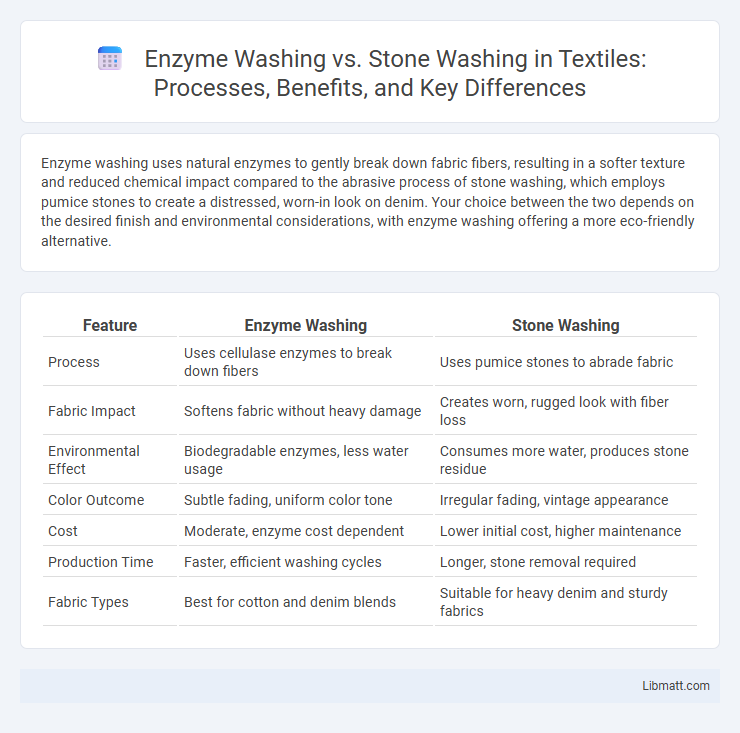Enzyme washing uses natural enzymes to gently break down fabric fibers, resulting in a softer texture and reduced chemical impact compared to the abrasive process of stone washing, which employs pumice stones to create a distressed, worn-in look on denim. Your choice between the two depends on the desired finish and environmental considerations, with enzyme washing offering a more eco-friendly alternative.
Table of Comparison
| Feature | Enzyme Washing | Stone Washing |
|---|---|---|
| Process | Uses cellulase enzymes to break down fibers | Uses pumice stones to abrade fabric |
| Fabric Impact | Softens fabric without heavy damage | Creates worn, rugged look with fiber loss |
| Environmental Effect | Biodegradable enzymes, less water usage | Consumes more water, produces stone residue |
| Color Outcome | Subtle fading, uniform color tone | Irregular fading, vintage appearance |
| Cost | Moderate, enzyme cost dependent | Lower initial cost, higher maintenance |
| Production Time | Faster, efficient washing cycles | Longer, stone removal required |
| Fabric Types | Best for cotton and denim blends | Suitable for heavy denim and sturdy fabrics |
Introduction to Fabric Finishing Techniques
Enzyme washing uses cellulase enzymes to selectively break down cellulose fibers, resulting in a softer fabric with reduced pilling and improved color fading control, making it ideal for sustainable garment finishing. Stone washing involves abrading fabrics with pumice stones, creating a worn-in look and softer texture but can be harsher on fibers and less environmentally friendly due to water and stone waste. Understanding these fabric finishing techniques helps optimize your denim or cotton garments' appearance and feel, balancing aesthetics with fabric longevity.
What is Enzyme Washing?
Enzyme washing is a textile finishing process that uses cellulase enzymes to selectively break down cellulose fibers on denim fabric, resulting in a softer texture and faded appearance without the abrasive damage caused by traditional methods. This eco-friendly technique enhances fabric durability and reduces water and chemical consumption compared to stone washing, which relies on pumice stones to create wear and distress effects. Enzyme washing provides a more controlled and uniform finish, making it a preferred choice in sustainable denim production.
What is Stone Washing?
Stone washing is a textile treatment process where garments are mechanically washed with pumice stones to create a worn, faded appearance and soften the fabric. The abrasive action of the stones removes surface dye and fibers, resulting in a vintage look and increased comfort. This method is commonly used in denim production to achieve a distressed, broken-in effect.
Process Comparison: Enzyme Washing vs Stone Washing
Enzyme washing uses natural enzymes to break down fabric fibers, resulting in a softer texture and reduced environmental impact compared to stone washing, which involves tumbling garments with abrasive stones to create a distressed look. While stone washing can cause significant wear and tear on denim and generate substantial wastewater, enzyme washing offers a gentler, more sustainable alternative that preserves fabric integrity. Your choice between these methods depends on the desired finish and your commitment to eco-friendly production processes.
Impact on Fabric Texture and Appearance
Enzyme washing uses natural enzymes to gently break down cellulose fibers, resulting in a softer fabric texture and subtle fading that enhances the garment's appearance without compromising durability. Stone washing, in contrast, employs abrasive pumice stones to create pronounced fading and a worn-in, rugged look, but can lead to increased fabric wear and reduced lifespan. Your choice between enzyme and stone washing affects not only the aesthetic outcome but also the tactile feel and durability of the fabric.
Environmental Considerations
Enzyme washing uses natural enzymes to break down fabric fibers, resulting in lower water consumption and reduced chemical waste compared to traditional stone washing. Stone washing relies on pumice stones, which contribute to higher water usage and pollution from abrasive particles. Enzyme washing offers a more eco-friendly alternative by minimizing environmental impact while preserving fabric integrity.
Durability and Longevity of Treated Fabrics
Enzyme washing preserves fabric durability by breaking down cellulose fibers gently, maintaining the strength and longevity of treated fabrics better than the abrasive stone washing process. Stone washing employs pumice stones that cause physical wear, leading to quicker fabric thinning and reduced lifespan. Your garments will retain their structural integrity longer with enzyme washing, ensuring a durable and lasting finish.
Cost Differences Between Methods
Enzyme washing typically incurs higher costs due to the expense of specialized enzymes and controlled processing environments, while stone washing involves lower upfront costs but higher equipment wear and tear. Stone washing consumes more water and energy, increasing operational expenses despite cheaper raw materials. Enzyme washing offers better fabric care and consistency, potentially reducing long-term maintenance costs compared to the abrasive nature of stone washing.
Application in Denim and Other Fabrics
Enzyme washing uses cellulase enzymes to soften denim and other cotton fabrics, providing a cleaner, more uniform finish with reduced fiber damage compared to stone washing. Stone washing employs abrasive stones to create a worn, distressed look, mainly on denim, but can cause fabric weakening and environmental concerns due to sediment release. Enzyme washing is preferred for sustainable textile processing, while stone washing remains popular for achieving high-contrast effects on denim.
Which Method is Best for Your Needs?
Enzyme washing uses natural enzymes to gently remove impurities and soften fabric, making it ideal for delicate textiles seeking an eco-friendly solution. Stone washing involves tumbling garments with pumice stones to create pronounced fading and texture but may cause more wear and environmental impact. Choose enzyme washing for sustainable, subtle aging effects and stone washing when a rugged, distressed look and heavier abrasion are desired.
Enzyme washing vs Stone washing Infographic

 libmatt.com
libmatt.com